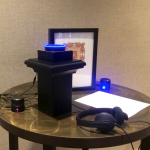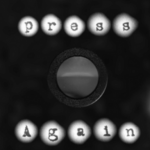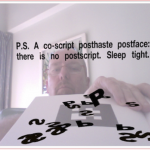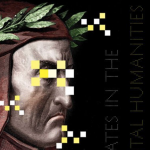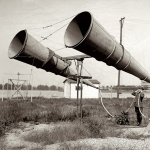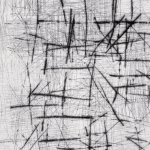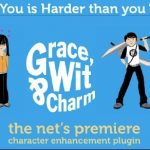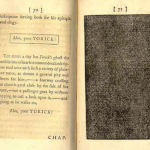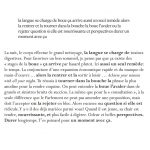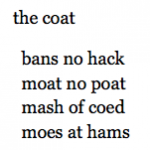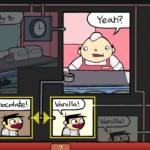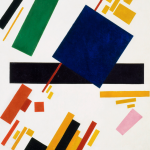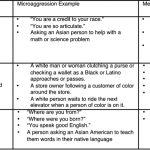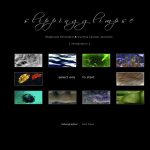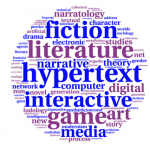2017
Reading practices have changed along the course of history. Before the ‘democratization’ of the written word - from Homer's Iliad to the medieval troubadours and to more recent public and private oral reading traditions -, reading has long been associated with listening. Today, in the age of algorithms and ‘smart’ interfaces, the sharing of language between humans and computational devices is increasingly ubiquitous and, with the standarization of artificial intelligence systems like Siri, Cortana, and Google Now, we are starting to speak and to listen to machines. In the field of digital literary creation, one example of aesthetic reflection on the questions raised by such networked ‘smart’ interfaces is John Cayley's The Listeners (2015), "a linguistic performance — transacted by visitors and Amazon’s voice-activated Artificial Intelligence and domestic robot, Alexa" (Cayley, 2015b). Through an analysis of The Listeners, articulated with Bernard Stiegler’s notion of the digital pharmakon, this paper aims to reflect on the encounter between literature and digital technologies. Three ideas will be highlighted: 1) the ways in which the technical, economic and political layers that constitute our digital devices pre-determine their usage (how they operate and are operated); 2) the automatic processing of language and orality as interfaces of mediation between humans and “smart” devices; 3) the literary implications of aurality and aurature.
Jeneen Naji describes Chris Funkhouser’s Press Again and Sonny Rae Tempest’s Famicommunist Poetics as examples of “the UnderAcademy style” begun by Talan Memmott. At the same time, within the context of post-digital publication, Naji explores concepts like "transcreation" and "translation" insofar as the two digital practitioners have conveyed experimental e-texts into print.
In this essay, Robert P. Fletcher demonstrates how, while putting together digital and print media affordances, augmented print may evoke in readers a sense of the uncanny. Fletcher also explains how works such as Amaranth Borsuk’s Abra (2014), Aaron A. Reed and Jacob Garbe’s Ice-Bound (2016) or Stuart Campbell’s Modern Polaxis (2014) seem to demonstrate the existence of a never-ending return of the “familiar” in electronic literature.
In a review that addresses (and exposes) the founding myth of the "digital humanities" (DH), formerly known as "humanities computing,” Roberto Simanowski and Luciana Gattass measure just how much the 99 articles collected by Mathew Gold and Lauren Klein have overturned "academic life as we know it."
Amazon’s Alexa, Apple’s Siri, Microsoft’s Cortana, and Google Now: How will our encounters with these intelligent personal assistants - robots we’ve invited into our homes to speak with and listen to us, who share this data with vectorialist institutions that monitor our networked transactions - alter both human language and our efforts to lead meaningful lives? In a wide-ranging, philosophical essay that exposes various myths of computation while presenting a candid assessment of the rapidly evolving culture of reading, poet John Cayley speculates that literature will be displaced by aurature. Listen up, readers: A major challenge in the programming era will be to develop linguistic aesthetic practices that intervene significantly and affectively in socio-ideological spaces thoroughly saturated with synthetic language that are largely controlled by commercial interests. The time for aesthetic experiments that disrupt the protocols of a still-nascent aurature is now.
This essay was reprinted in part for the Handbook on Electronic Literature (Bloomsbury 2018).
In this essay, Ortega departs from Ulises Carrión’s notion of book as a “spatio-temporal entity” which goes beyond verbal language, in order to demonstrate how hybrid works (or "textual environments") such as Amaranth Borsuk’s Between Page and Screen (2012) may create “new genres and material and poetic expressiveness.” By drawing on Rita Raley’s “TXTual practice,” Ortega also demonstrates how the "material dynamics" displayed by these works decisively contributes to the generation of meaning.
2016
In this review, Manuel Portela considers Matthew G. Kirschenbaum's Track Changes in light of a "general computerization of the modes of production of writing."
Jen Phillis situates Jessica Pressman's Digital Modernism: Making It New in New Media as a rejoinder to "Neoliberal Tools (and Archives)" by David Allington, Sarah Brouillete, and David Golumbia.
Katherine Hayles, Hyper and Deep Attention: http://www.jstor.org/stable/25595866?seq=1&cid=pdf-reference#references_tab_contents
Bernard Stiegler's "Relational Ecology and the Digital Pharmakon."
2015
In Pasts and Futures of Netprov, Rob Wittig articlates a theory for Networked Improv Narratives, or "Netprovs." Wittig, an innovator in this novel form, situates netprov at the interesection of literature, drama, mass media, games, and new media. Transcribed from a presentation given at the Electronic Literature Organization conference in Morgantown, WV, Wittig explores a number of antecedents to the form, documents current exemplars of this practice, and invites readers to create their own networked improvisations.
In this keynote address to the 2014 Electronic Literature Organization Conference, Illya Szilak highlights the power of "minor forms" in digital literature. Through a wide-ranging survey of works, Szilak identifies the tendency for "failure" in electronic literature as its most powerful feature: its capacity to deterritorialize the parameters of discourse and expand the potential of subjectivity in the process.
In this essay, John Cayley builds upon a critical legacy that reflects intensively on the process of literature in an age of machine language. Building on a legacy that includes ebr classics like “The Code is not the Text” and many points in between, “Beginning with ‘The Image’” points to the difficulties of translating a procedural code-based text that “finds” its substance in the repository of text known as the World Wide Web.
In this essay John Cayley reviews Nick Montfort’s #!, a book of computer generated poetry and the code that generated it. Exploring the triangle of Montfort’s programs, the machines that read them, and the output presented for human readers, Cayley situates the experience of reading and writing as intrinsically virtual, powered by its sustained potentiality, rather than its definitive comprehension.
Salter's "Convergent Devices, Dissonant Genres" assesses the implications of the iPad for the state of literature. Looking at "traditional" approaches that re-mediate print for digital devices, "enhanced" approaches which add "special features" to extant texts and forms, pre-tablet eliterature re-experienced in the new environment, and finally the creation of original apps with literary qualities, Salter's work is a critical document of the impact a single interface can have on the development of literary culture in the 21st Century.
2014
E-lit authors Stephanie Strickland and Marjorie Luesebrink organized a panel on the "Future of E--Lit" at the ELO 2012 conference, allowing emerging and early career authors to articulate institutional and economic, as well more familiar technological, developments that constrain and facilitate current practice. The panel papers were released in ebr in March 2014. Luesebrink and Strickland followed up with comments on the papers, offering a "progress report" on the future of the field. The individual responses are available as glosses on the essays and in full here.
The authors discuss their effort to raise critical awareness about microaggressive racist behavior with Mimesis, an interactive game set in an underwater environment where players become sea creatures, and where they feel the social force of microaggression regardless of the their race or ethnicity.
Crossing the tools of fluid dynamics with those of literary criticism, Gwen Le Cor casts a new light on contemporary writing in new media. Unlike first generation, "classical" hypertexts that were non-linear in the sense of using linked textual elements, Le Cor sees Strickland and Lawson Jaramillo's poem, slippingglimpse, as a more "contemporary" instance of nonlinear writing that can be viewed (literally) as a "complex, nonlinear turbulent system."
In PAIN.TXT, Alan Sondheim and Sandy Baldwin explore the limitations of expression at the borders of human sensation. Derived from a dialog between Sondheim and Baldwin on extreme pain, this essay considers how one signifies intensity and another attempts to interpret that intensity, and the challenges this process poses for affect, imagination, and ultimately intersubjectivity. In keeping with the content of this piece, the two preserve the dialog format, recreating for readers a discourse on p...
Jill Walker Rettberg’s Visualizing Networks of Electronic Literature maps the fragmentary and dynamic field of electronic literature by analyzing citations in 44 doctoral dissertations published between 2002 and 2013. Applying “distant reading” strategies to the ELMCIP Knowledge Base, Rettberg identifies key works in the field, shifting genres, and changing approaches to scholarship.
